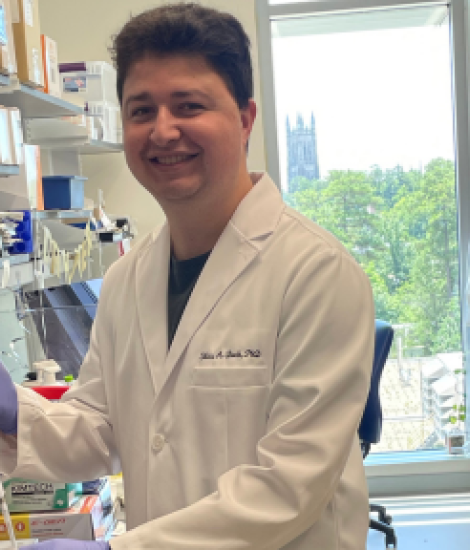My PD Story

Silas Buck, PhD
2024 Postdoctoral Fellowship
Uncovering a Missing Link Between Genetic Mutation and Protein Clumping in PD
Several genetic mutations linked to the development of Parkinson’s disease (PD) have been discovered over decades of research. However, fully understanding how those mutations can cause PD is an ongoing scientific challenge.
Learn more about PD GENEration: Mapping the Future of Parkinson's Disease, which offers genetic testing and counseling at no cost for people with PD.
One such PD-associated mutation leads to the production of a malfunctioning version of the protein LRRK2. Faulty LRRK2 is believed to disrupt several important processes within neurons and consequently contribute to PD progression, but how exactly these disruptions lead to the disease is still being studied.
Silas Buck, PhD, recipient of a Parkinson’s Foundation Postdoctoral Fellowship, believes a relatively understudied protein may be affected by mutant LRRK2 and drive PD-related cellular breakdown. Through his experiments, he will seek to understand how this protein (called HDAC6) is corrupted in LRRK2-associated PD and how we might use this knowledge to create new treatments that prevent disruption to slow the disease.
When looking at the posthumous brain tissue of people who had LRRK2-mutant PD, scientists have routinely seen unhealthy aggregates or clumps of a protein called tau. Similar to alpha-synuclein clumping, tau clumping is believed to contribute to the disease-related breakdown of dopamine neurons and is associated with PD dementia. HDAC6 is a protein with many responsibilities, one of which is to regulate tau and keep it from clumping. However, Dr. Buck hypothesizes HDAC6 may be a missing link connecting LRRK2 to tau clumping in PD.
“Determining the potential positive effect of HDAC6 inhibition in Parkinson’s disease could have an immediate impact on people with Parkinson’s disease,” said Dr. Buck.
Dr. Buck, working in the lab of Dr. Laurie Sanders at the Duke University School of Medicine in Durham, NC, a Parkinson’s Foundation Center of Excellence, will be conducting research to see if and how mutant LRRK2 causes disruptions in HDAC6 that lead to PD-associated tau clumping. Using neurons grown in petri dishes, Dr. Buck will first measure how much LRRK2 and HDAC6 interact in healthy brain cells.
Then, he will introduce mutant LRRK2 into those cells and analyze how that affects the LRRK2-HDAC6 interactions and if such changes result in tau clumping. Finally, Dr. Buck will investigate if mutant LRRK2’s impact on HDAC6 also contributes to disrupted mitochondria repair and cleanup, another cellular stressor commonly seen in PD brain tissue.
Uncovering more biochemical links in the chain between gene mutation and PD means more opportunities to intervene in the disease’s progression. Through Dr. Buck’s experiments, we will understand more about HDAC6’s role in PD development and how it could be the target of new future therapies, expanding the effective medication options and improving doctors’ ability to provide genetically personalized treatment plans for people with Parkinson’s.
When asked about the personal and scientific impact of this Parkinson’s Foundation support, Dr. Buck said “Receiving this postdoctoral fellowship allows me to pursue my passion of performing exciting and important research that could one day help substantially improve the lives of people with Parkinson’s disease. It has always been my dream to make a difference in the health of others through research, and I hope to achieve that through this project.”
Meet more Parkinson’s researchers! Explore our My PD Stories featuring PD researchers.
Related Materials
More Stories
from the Parkinson's community


